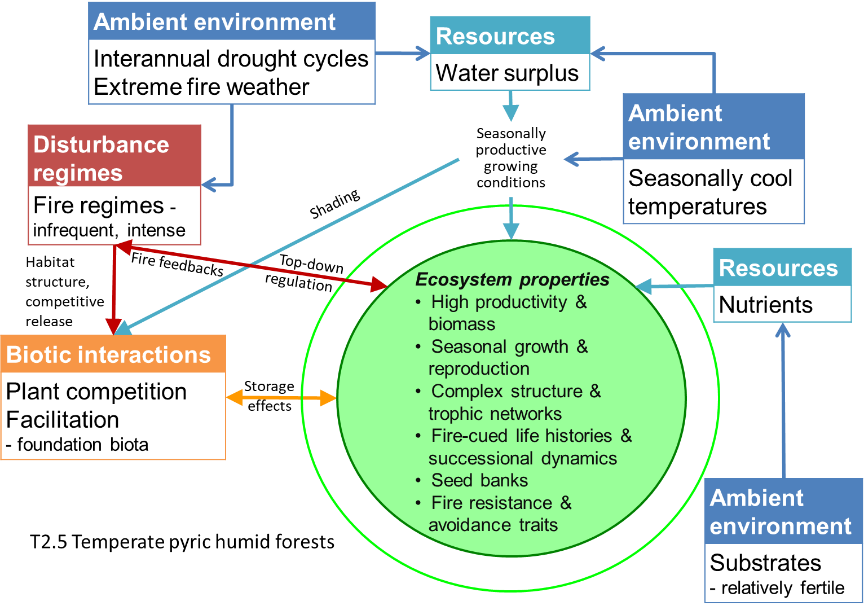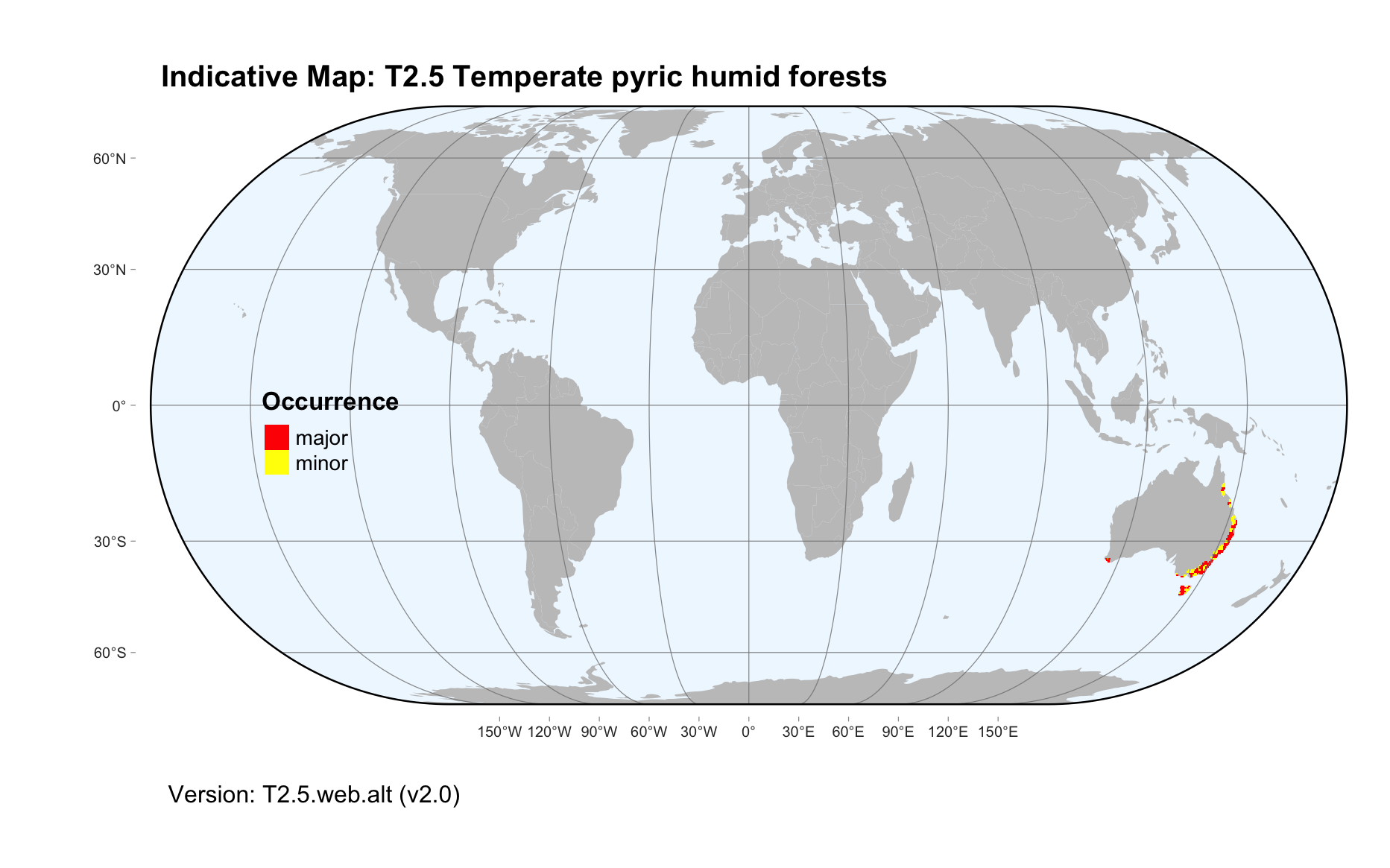Global ecosystem typology
Alternative site for the Global ecosystem typology with additional information for ecosystem profiles and indicative maps.
This site is maintained by jrfep
T2.5 Temperate pyric humid forests
Biome: T2. Temperate-boreal forests and woodlands biome
Contributors:
(texts)
Forests with the tallest flowering trees on earth are complex in structure, with an open canopy of sclerophyll trees 40-90m tall allowing light to filter through to multiple understorey layers and a ground flora of ferns, grasses and mosses. The complex forest structure sustains a high diversity of birds, reptiles mammals, and canopy invertebrates, as well as a moist microclimate and deep, moist leaf litter on the forest floor that supports a diversity of soil invertebrates, fungi, and other microbes. These highly productive, fast-growing forests are notable carbon sinks, but extreme droughts make them prone to the most ferocious forest fires on earth at century-scale intervals. Seedbanks are crucial to the forest persisting after fire.
Key Features
Tall, moist and complex multi-layered forests in wet-temperate climates; characterised by sclerophyll dominant trees and diverse mesophyll understorey; population processes driven by fire regimes.
Overview of distribution
Subtropical - temperate southeast and temperate southwest Australia.
Profile versions
- v1.0 (2020-01-20): DA Keith; RC Mac Nally
- v2.0 (2020-06-15): DA Keith; RC Mac Nally
- v2.01 ():
- v2.1 (2022-04-06): DA Keith; R Mac Nally Full profile available at official site
Main references
Selected references for this functional group:
Mac Nally RC (1995) On large-scale dynamics and community structure in forest birds: Lessons from some eucalypt forests of southeastern Australia Philosophical Transactions of the Royal Society B 350B: 369-79
Wardell-Johnson G, Neldner J, Balmer J (2017) Wet sclerophyll forests Australian vegetation (Ed. DA Keith), pp 281-313. Cambridge University Press, Cambridge. ISBN 978-1-107-11843-0
Diagrammatic assembly model

Maps
Maps are indicative of global distribution patterns are not intended to represent fine-scale patterns. The maps show areas of the world containing major (coloured red) or minor occurrences (coloured yellow) of each ecosystem functional group. See general notes on maps.
There are 2 alternative versions of the indicative map for this functional group, please compare description and sources below.
T2.5.IM.alt_v2.0
Datasets
- KG-climate-2018
- Vegetation-height-Australia
- Vegetation-height-Australia
Map references
Beck, H., Zimmermann, N., McVicar, T. et al. (2018) Present and future Köppen-Geiger climate classification maps at 1-km resolution Sci Data 5, 180214 DOI:10.1038/sdata.2018.214
Armston, J., Scarth, P., Lucas, R., Lewis, P., Disney, M., Phinn, S. (2015) Validation of continental scale vertical plant profile mapping using waveform lidar airborne laser scanning Silvilaser 2015 (Conference Proceedings). La Grande Motte, France, 28-30 September.
Hao Tang, John Armston, Steven Hancock, Suzanne Marselis, Scott Goetz, Ralph Dubayah (2019) Characterizing global forest canopy cover distribution using spaceborne lidar, Remote Sensing of Environment 231: 111262 DOI: 10.1016/j.rse.2019.111262
T2.5.web.alt_v2.0

Datasets
- Vegetation-height-Australia
- KG-climate-2018
- Vegetation-height-Australia
Map references
Armston, J., Scarth, P., Lucas, R., Lewis, P., Disney, M., Phinn, S. (2015) Validation of continental scale vertical plant profile mapping using waveform lidar airborne laser scanning Silvilaser 2015 (Conference Proceedings). La Grande Motte, France, 28-30 September.
Beck, H., Zimmermann, N., McVicar, T. et al. (2018) Present and future Köppen-Geiger climate classification maps at 1-km resolution Sci Data 5, 180214 DOI:10.1038/sdata.2018.214
Hao Tang, John Armston, Steven Hancock, Suzanne Marselis, Scott Goetz, Ralph Dubayah (2019) Characterizing global forest canopy cover distribution using spaceborne lidar, Remote Sensing of Environment 231: 111262 DOI: 10.1016/j.rse.2019.111262
Check: the Glossary / Profile structure / the public document